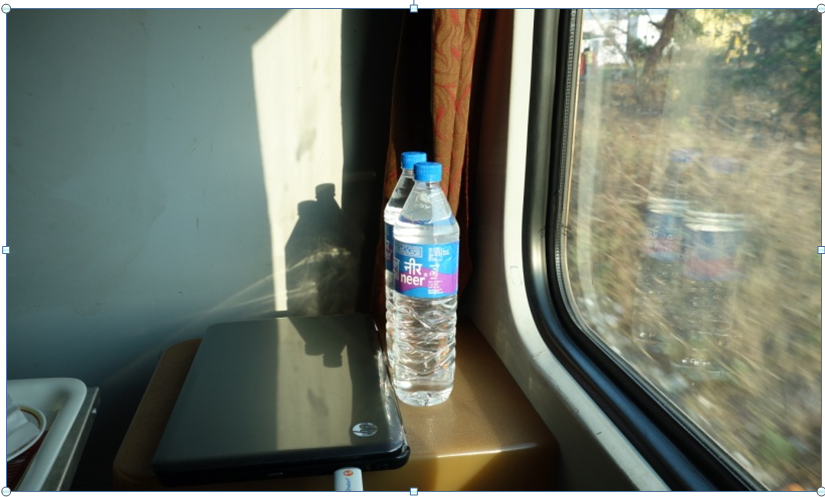Energy Conservation – Train Lighting and Air Conditioning
Power supply for Train Lighting and air conditioning is provided either by Self generation or End on Generation system.
Estimation of energy consumption for Train Lighting and Air Conditioning
SG Coaches
- Holding of Self Generation Coaches: AC=8000; Non-AC=38000
- Installed Capacity of power Generation = No. of coaches * Generation Units/coach
- AC Coach: 8000*50kW=400000kW; Non-AC coach: 38000*4.5kW=171000kW
- Total installed Capacity= 571000kW; considering 75% on line availability, 16hrs coach working per day and redundancy factor of 0.6, Genr and Non-genrr of 2/3;
- Self generation is estimated at
571000*0.75*16*0.6* (2/3) =2740800kWh or 2.74Munits/day or 1.0B units/year
- 50% of this energy is accounted in Electric Traction Bill and balance on Diesel Traction.
- Also a 4000 coaching mail/express trains operates per day therefore, on an average 685 units of energy is consumed per train per day.
EOG Coaches
EOG system is adopted for fully Air conditioned trains such as Rajdhani, Shatabdi, Duranto and Garib Rath etc. Power car installed with 2 nos. 500kW DG is provided one number at each end. The oil consumption per trip from Mumbai to New Delhi and back for powering 21 coaches consumes approximately 100 liters/hour of oil. Energy and fuel meter readings are not available and thus assessed as the average consumption for a period of 10-12 trips. Average oil consumption per kWh is 0.25 lts based on measurement on two power cars meaning thereby consumption 400 units per hour mainly for air conditioning load. This gives good scope for energy conservation. This is quite a significant energy when compared to consumption of 1400 units of energy per hour for traction.
This consumption in Electrical and Diesel energy is quite significant when compared with 2.5 B units consumed for non – traction purposes by IR where most of the energy conservation efforts are concentrated.
Measurements for Energy Conservation
“You cannot manage what you cannot measure” Attributed to Bill Hewlett (1930-2001), Cofounder of Hewlett-Packard
“Until you can measure something and express it in numbers, you have only the beginning of understanding” William Thomson [Lord Kelvin (1824-1907)]
The measures so far adopted had been to improve the energy efficiency of equipment installed for train lighting and air conditioning on assumed basis. Theoretical analysis has been done to understand the consumption trend which will not help in developing strategies for energy conservation measures. Energy meters shall be installed on sample 100 AC and TL coaches for continuous monitoring of trend of energy consumption at any instant of time for identifying the scope of energy conservation. Similarly, Energy and fuel meter in every power car to compare trends of consumption with respect to season, time of the day, effect of the number of coaches and person etc.
Scope of Energy Conservation
- With energy data available for a coach, it will be possible to compare the trend in a group of coaches working at the same time and weather condition. The coaches consuming energy at the extreme ends of the band will help in investigating the causes.
- EOG power shall not be used for testing of rake during maintenance as the unit cost of DG set is three times more than utility power. Three phase 750V system line be provided on washing lines for testing of rakes for facility of testing of two coaches with AC ‘on’ at a time and total rake for lighting and control load.
- HOG is the most preferred system for powering train lighting and air conditioner load. The locomotive is provided by Hotel load which is supplied to the train load and evaluated as the most energy efficient systems based on the studies done on one locomotive equipped with HOG system. NR provided HOG on locomotive number 30277WAP7 to work 2005/2006 Kalka Shatabdi and as per RDSO study, an annual saving of Rs. 55lakhs/year for this train alone is estimated besides avoiding noise pollution and atmospheric pollutants at Railway Station, a great relief to the passenger.
- Some of the other scope for energy conservation
- Audit about wrong practice and Review of air insulation of AC coaches depending upon new technologies. The video below gives an absence of sun film on window look out glass leading to increase air conditioning load.

- VRF technology with individual cabin temperature control. Cu pipes will run instead duct thus helping in reducing the height of the coach particularly in AC 3 tier. When individual seat air flow control in provided in an aircraft, it should be possible for the train also. This will certainly reduce the AC load as otherwise many passenger uses blankets to keep them warm.
- Reverse cycle for heating requirement
- Soft start of RMPU by configuring 25kVA inverter
- Permanent Magnet Alternator reduces weight and energy efficiency
Demand of Air conditioned coaches will certainly be going up. Fare structure recovers the cost of air conditioning and in fact is financially viable as compared to sleeper coaches. There is demand for air-conditioning of EMU/MEMU coaches. Energy efficiency is going to play a very important role. SEC of EMU train will jump to 55-60 on an AC coach from the present level of 30-35 . How Indian Railways going to recover additional cost is a challenge. The fare structure of DMRC/BMRCL etc. helps in recovering the cost . Independent research facilities are essentially required at RDSO to evaluate energy efficiency of different design. There should be a system to evaluate the energy efficiency of RMPU after every 5 years of service. Who knows it may be an eye opener and provides clues to save on energy.
References
Very nice and informative article